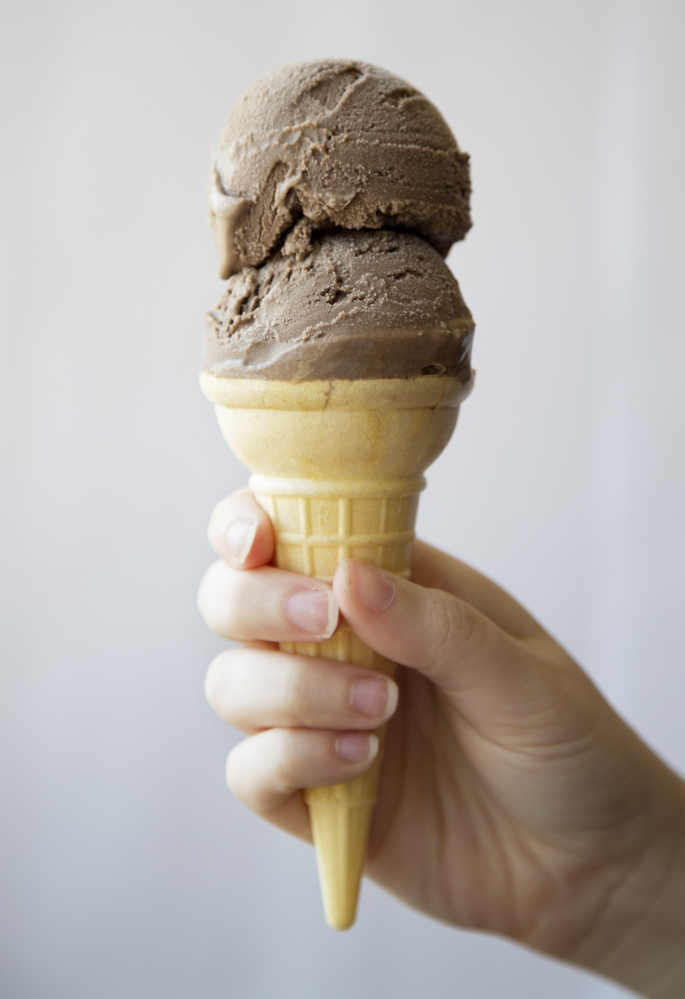Ice-cream-loving Mainers know Mount Desert Island Ice Cream for its delicious and often exotically flavored varieties, which have won the company national recognition, including a place on 2011 Food & Wine magazine’s list of Top 25 Ice Cream Parlors.
But fewer people know the company – with two stores in Bar Harbor, one in Portland and a statewide wholesale business – is also known for its sustainable business practices. It’s won accolades for that, too, including a spot on Mother Earth News’ Top 20 Artisan Ice Cream Companies that rank high in responsible sourcing, recyclable packaging and lower-impact energy use.
Proprietor Linda Parker keeps staple flavors – vanilla bean and chocolate ice creams, plus crowd-pleasers like Maine sea salt caramel and Nutella – in her freezer case at all times. She ventures farther afield with such items as Thai chili-peanut ice cream, celery leaf ice cream with sherry-soaked raisins and hibiscus-grapefruit sorbet.
Coming up with novel flavors, she says, is considerably more fun than stressing out about fluctuating local milk and cream supplies, adhering to proper waste management procedures, and investigating various energy-conservation measures to figure out which suits her company best. Parker’s goal of operating an environmentally friendly business, season after season, is not without its bumps.
For instance, until recently, Parker bought her milk and cream from Maine’s Own Organic (MOO) Milk. But the company suddenly announced in May that it was shutting down (an attempt to revive the brand failed last week). She had to scramble to find another supplier just as the booming summer season got underway.
For now, she is working with the Maine Organic Farmers and Gardeners Association (MOFGA) to source enough milk and cream to meet the demand.
Also, Parker wishes for more Maine-based professional services that would help companies like hers with recycling and composting. For now, recycling efforts “are manual, time-consuming processes we handle ourselves,” she said.
And tapping alternative energy sources and shoring up conservation measures is a constant concern for Parker. After all, her company is churning and freezing upwards of 600 gallons of ice cream and sorbet weekly, tasks that demand a lot of energy. Parker finds the options for renewable energy exciting, but the implementation daunting.
But this month is National Ice Cream Month, so Parker is trying to be chill about taking on any new conservation measures until tourist season subsides.
“Sustainability is a process, right?” she says. “I’m confident we will get to the goal in the end.”
BRIGADARO ICE CREAM
We’ve borrowed Mount Desert Ice Cream’s recipe for chocolate-caramel ice cream, but changed the technique to a kick-the-can method, which expends more human energy than any other type.
You will need two metal coffee cans, in 1-pound and 3-pound sizes, each with a lid, rock salt and possibly a few energetic small children.
If you prefer, you can churn the ice cream in an ice-cream maker, following the manufacturer’s instructions.
Makes about 2 quarts
1¾ cups whole milk, divided
2½ cups heavy cream
1 (12-ounce) can evaporated milk
¾ cup sugar
1 (14-ounce) can sweetened condensed milk
5 tablespoons unsweetened cocoa powder
1 tablespoon butter
¼ teaspoon salt
Fill a large bowl with ice and water; set aside.
Mix 1½ cups of milk, the cream, evaporated milk and sugar in a medium saucepan over medium heat, then bring to a boil. Boil the mixture for 3 minutes, stirring frequently. Remove from the heat and set aside.
Combine the sweetened condensed milk, cocoa, butter, salt and remaining ¼ cup whole milk in another medium saucepan and warm over medium-low heat until the ingredients are combined. Raise the heat to medium and continue cooking until the mixture is thickened, stirring constantly, about 5 minutes.
Remove from the heat and pour into the milk-cream mixture. Return the combined ice-cream base to medium heat, whisking to combine. Remove from heat and pour into a medium bowl. If any lumps of cocoa powder remain, use an immersion blender to incorporate them.
Set the bowl in the ice water bath you prepared earlier until the ice cream base is cool to the touch, about 20 minutes. Refrigerate for at least 2 hours or until completely cool, preferably overnight.
When the mixture is thoroughly chilled, pour half of it into a clean 1-pound coffee can. (The remaining base will keep in the refrigerator for about a week until you are ready for more ice cream.) Place the lid on the can, secure it with duct tape, put the small can inside a 3-pound coffee can, and add rock salt and ice to the space between them. Seal the larger can tightly and let some high-energy children kick it around for about 20 minutes to freeze the mixture inside.
Send questions/comments to the editors.



Comments are no longer available on this story